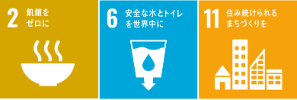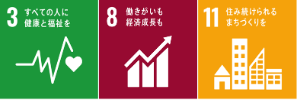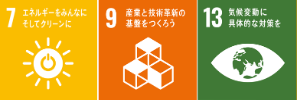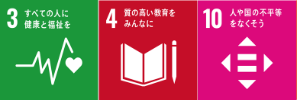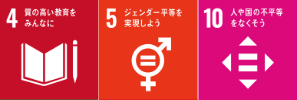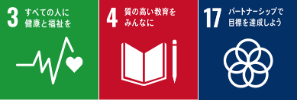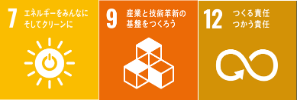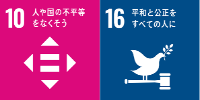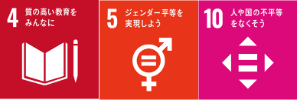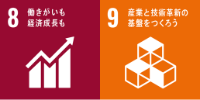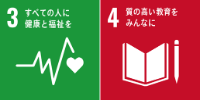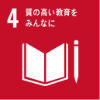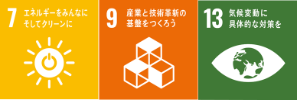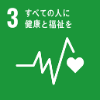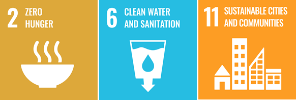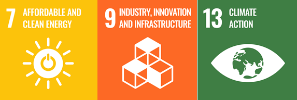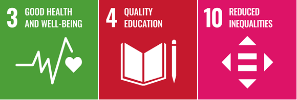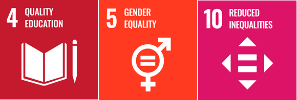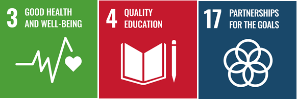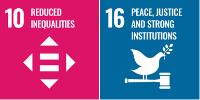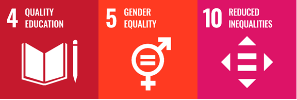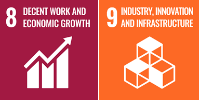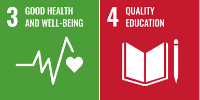研究課題Research Subjects
2024年度
*研究代表者名のアルファベット順
-
下水汚泥の肥料としての価値-土壌微生物への影響
-
社会的孤独を緩和するための寄り添い会話ロボットシステムの構築
-
再生可能エネルギー安定供給を実現する高温熱エネルギー貯蔵材料の開発
-
教育不全・不平等の改善:動物モデルを用いた難聴に起因する教育受容の障がいの治療法開発とその評価
-
性的マイノリティ(LGBTQ+)が生きやすい社会の実現に向けた実証分析
-
大学生によるシリアスゲーム開発の効果検証―アルコールと社会と私をテーマにしてー
-
広範なひずみ速度下でのナノ〜マイクロ繊維の機械的特性評価手法の開発
-
週刊文春の取材・報道と権力監視に関する研究
-
私立大学のダイバーシティ推進:ダイバーシティの共創に向けて
-
中小企業においてDXが従業員の働き方をどのように多様化させるのか―日本の中小企業における有効な人材確保を目指して―
-
子どもの教育環境改善を目指すための、心身の健やかな発達基盤の確立
-
生成AIに対する信頼「ギャップ」に係る行動経済学的研究:デジタル教育を促進するナッジ開発を目指して
-
SARS-CoV-2スパイクタンパク質を標的とした新規COVID-19治療薬の創製
-
不確実性下における脱炭素電源投資の価値評価モデル開発
-
資源に優しい行動の促進に資する次世代育成プログラム開発に関する研究ー生物多様性保護行動と医療のエコ行動に着目してー
-
難病メカニズム解明のための高次元データ解析法の開発
-
持続化可能な都市のためのベーシックインカムと連帯経済
下水汚泥の肥料としての価値-土壌微生物への影響
研究代表者:赤尾 聡史(理工学部 教授)
研究概要
窒素とリンは、カリウムと並んで肥料の三大要素です。一方、これらの天然資源は偏在性が大きく、資源を有さない国々の安定的な農業生産に暗い影をもたらしています。また、地中から生態系に拡散した窒素・リンがその許容量を超え、生態系にとって壊滅的な影響をもたらす恐れも指摘されています。天然資源の依存率を下げる、つまり、生態系に拡散した窒素とリンを利用する方策が重要となります(目標11,目標12:持続可能性)。さらに、技術を有する国々が率先して天然資源の依存率を下げることで、世界全体の食料安定供給につながります。世界人口が増加し続ける時代においては、食料増産と安定供給は喫緊の課題です(目標2:飢餓)。ところで、食料生産に利用された窒素とリンは我々の排泄物中に含まれることになります。本研究では、下水道に集まり排出される下水汚泥を肥料として利用する、このシステムをサポートするために下水汚泥由来の肥料の魅力を伝える研究を行います。現在、老朽化した下水道の維持が既に社会問題になっています。我々の日常生活から排出される物質が集まる下水道を資源のソースと捉え、下水道を社会の中で生産的な要素として見直すことで経営的な安定性を見出し、下水道の維持あるいは途上国におけるトイレを含めた衛生設備の普及につなげたいと考えます(目標6:水・衛生)。
研究成果
本研究は,SDGsの目標に対して,1)食料生産に欠かせない肥料の供給:目標2(飢餓),2)下水処理過程で生じる廃棄物を利用:目標6(水・衛生),3)地域で発生する資源を地域の産業で利用し,関連する業務を創造:目標11(持続化可能な都市),という点で関わる.肥料は国際的な戦略物質となりつつあり,安定した肥料調達・食料生産を目的に下水汚泥堆肥の利用が期待されている.本研究では,土壌の生物性および化学性の測定を通じて下水汚泥堆肥の施用が土壌細菌および肥料成分の変換に及ぼす影響について検討した.圃場での実地調査の結果,下水汚泥堆肥の施用後に窒素循環,リンの可給態化,および植物病害防除に寄与するとされる細菌群の増加を確認した.同堆肥の施用前後で細菌群集構造は変化し,細菌群集に対する機能予測解析から硝化作用や硝化還元作用およびリンの可給態化に関与する機能の活性化が推測された.また,下水汚泥堆肥を用いた室内培養実験から,同堆肥は牛ふん堆肥と同等以上に窒素循環機能およびリンの可給態化の機能を活性化させることを確認した.下水汚泥堆肥の施用が土壌細菌を活性化し,同堆肥を窒素源あるいはリン源として十分に機能させることを確認した.
関連するSDGs:
社会的孤独を緩和するための寄り添い会話ロボットシステムの構築
研究代表者:飯尾 尊優(文化情報学部 准教授)
研究協力者:米永 涼香(文化情報学研究科 修士課程)
研究概要
研究成果
本研究では、「SDGs目標3:すべての人に健康と福祉を」と「目標11:住み続けられるまちづくりを」の達成に向け、社会的孤独・孤立に対する新たな解決策として、寄り添い型会話ロボットの有効性を実証した。特に一人暮らしの大学生を対象に、長期間の対話を通じてロボットとのアタッチメントが形成され、自己肯定感や安心感の向上に寄与することが示された。
このようなロボットの介入は、相談機関にアクセスしづらい人々に対する支援の選択肢となり、精神的健康の改善や孤独の緩和に資する。また、対話履歴をもとに個別化された応答が可能となるシステム設計は、今後高齢者施設や教育現場など多様な領域への応用が期待される。ロボットを通じて人々の「日常のそばにいる存在」を創出することで、心のケアを身近に提供する社会の実現を目指す。
関連するSDGs:
再生可能エネルギー安定供給を実現する高温熱エネルギー貯蔵材料の開発
研究代表者:小畠 秀和(理工学部 教授)
共同研究者:小澤 俊平(千葉工業大学 教授)
研究協力者:Jürgen Brillo(German Aerospace Center Scientific staff)
研究概要
様々な技術開発により私たちの国の再生可能エネルギーの発電コストは2030年には、化石燃料による発電とほぼ変わらない試算とっているにも関わらず普及は進んでいません。この大きな要因の一つが、太陽光発電や風力発電では、その日の天候などによって十分な発電を行うことができないなどエネルギーを安定供給できないところにあります。そのため、再生可能エネルギーを進めるためにはこの電力供給の不安定性を解消することが必要です。
このような問題を克服するために、近年、熱エネルギー貯蔵が注目されています。この熱エネルギー貯蔵を使えば、再生可能エネルギーで得られる安定な電力を一度熱として貯蔵して安定化させ、必要に応じてその熱エネルギーを使って安定に発電できる社会が実現できると考えられています。この研究では、この未来のシステムの実現に向けて 1) 熱を効率よく貯蔵・放出できる材料、2) 高温での材料の反応を抑制しシステムの劣化を防ぐ材料の開発を進めていきます。
研究成果
再生可能エネルギーの発電コストは化石燃料と同等になると予測されるものの、供給の不安定性が普及の課題となっています。この課題解決の鍵となるのが、エネルギーを熱として蓄え、必要に応じて発電に活用する「熱エネルギー貯蔵」です。本研究では、①高効率な蓄熱・放熱材料、②高温環境下での劣化を防ぐ材料の開発を進めています。
2024年度には、ガスジェット浮遊装置を用いた新たな潜熱測定法を開発し、高融点金属の潜熱を高精度に測定する手法を確立しました。また、国際宇宙ステーションの静電浮遊法を活用し、FeCu合金の表面張力や粘性を測定しました。これらの成果は、持続可能なエネルギー利用(SDG7)や産業技術の革新(SDG9)に貢献するものです。さらに、ドイツ航空宇宙センターと国際共同研究を進め、基礎研究から実用化に向けた研究を加速させています。
関連するSDGs:
教育不全・不平等の改善:動物モデルを用いた難聴に起因する教育受容の障がいの治療法開発とその評価
研究代表者:小林耕太(生命医科学部 教授)
研究協力者:中川 喜嵩(博士課程)、福沢 惠美(博士課程)、新家 一樹(博士課程)、西堀 諒(博士課程)
研究概要
難聴は知覚障がいとして最も頻繁に観察されるものであり、特に小児難聴は言語能力の獲得を困難にするだけでなく、コミュニケーション機会自体を奪うため、対人関係を構築する能力を学習・獲得するうえでも障害となる。そこで本研究では、2種の齧歯目動物を対象として、先天性難聴と後天性(発達期ストレス)の両方からコミュニケーション能力低下を引き起こすメカニズムを解明することを目的とする。本研究の成果は、SDGs(目標3, 4, 10)達成につながると期待できる。
先天性難聴実験には、申請者らの研究室が難聴モデル動物として確立したMAP2(Microtubule-associated protein 2)遺伝子欠損マウスを使用する。後天性障がいの実験には、幼少期に母仔を一定期間隔離し、ストレスを与える母仔分離操作を経験したスナネズミを使用する。聴覚感度の評価は聴性脳幹反応検査により測定し、コミュニケーション能力を評価するため複数個体Open Field Testにより社会性の発達を定量化する。本研究の目的を達成することで、コミュニケーション障害の治療法の創出に貢献できると考える。
研究成果
教育を受けるためには様々な能力が必要であり、特にコミュニケーションは必須の能力である。本研究計画では、先天性および後天性難聴がコミュニケーション能力に与える影響とそのメカニズムを解明することを目的とした。MAP2遺伝子欠損マウスを用いた先天性難聴モデルでは、聴覚および社会性の評価の結果、難聴が不安傾向を高め、社会性の発達に影響を与えることが示唆された。また、母子分離スナネズミを用いた後天性難聴モデルでは、聴覚および社会性の評価の結果、聴覚感度の低下、音声周波数の変調構造の変化が確認され、さらに他個体との同居に障害を及ぼすことが明らかとなった。また、コミュニケーション障がいのうち一部の症状については、正常発達の個体とのインタラクションを通じて回復する可能性が示された。
本研究により、難聴がコミュニケーション能力に影響を与え、社会性異常を引き起こすことが示された。この結果は聴覚に障がいを持つ人の社会的包摂を促進し、教育・福祉の向上に貢献することで、SDGsの課題である聴覚障がいによる教育の不平等問題の解決に寄与できるだろう。
関連するSDGs:
性的マイノリティ(LGBTQ+)が生きやすい社会の実現に向けた実証分析
研究代表者:内藤 徹(商学部 教授)
共同研究者:北 美幸(北九州市立大学 外国語学部 教授)
研究協力者:阪田 真己子(文化情報学部 教授)
研究概要
本申請研究の目的は、性的マイノリティ(LGBTQ+)の人々にとってより生きやすい社会を実現するための処方箋を提示することにある。日本財団が2021年におこなった調査によると1997年から2003年に生まれたZ世代のうち「自分がLGBTQ+である」との回答は20.8%にも達している。もはや、男性/女性二元論でジェンダーを捉えることは難しく、SOGI(Sexual Orientation and Gender Identity、性的指向および性自認)が多様であることを前提としたダイバーシティの推進施策が求められている。高等教育機関である大学においても、これらLGBTQ+とされる学生・教職員に対する就学・勤務の整備は必要不可欠であり急務であるが、その対策を立てる基礎となる研究知見が非常に希薄である。このことを踏まえ、国内外における教育機関における取組を調査し、類型化を行い、さらには定量・定性分析を行う。さらにその知見を基に高等。教育機関(主に大学)における適切な対策・政策を明らかにする.また本研究は、北九州市立大学と学術協定を締結し、研究をより強力に推進する。具体的には、調査(聞き取り)、類型化、定量化・処方箋の提示、知見の公開の順で実施する。
研究成果
近年,ジェンダーフリーに関する案件は非常に高いモノになっている.大学をはじめとする教育の現場においてもその対応を迫られている.米国や台湾などのように同性婚が認められるなどLGBTQへの理解がある国がある一方,日本のように同性婚が認められてない国が存在する.またこのような問題はセンシティブな要素を含むため実態が把握することが容易でないという事実もある.このような性的マイノリティさらには各種のマイノリティと言われる人々がストレスフリーで生活できる社会を構築するためにはその実態を把握する必要がある.本プロジェクトでは,LGBTQ当事者とのインタビューや意見交換を行い,その実態を把握すると同時に,メンターである講師を複数招聘し,性的マイノリティにとってストレスフリーな社会を構築するために必要なものについて研究を行った.プロジェクトを遂行した結果,日本においても多様性に対する理解や教育機関のダイバーシティの取り組みは増加し,その質も向上していることは認められたが,就職活動等に対して依然としてLGBTQの学生が不安を持っていることなどが明らかになった.また,国外のケースについても現地に足を運び視察した結果,本学でもより一層取り組みを強化してくことが肝要であることが明らかになった.
関連するSDGs:
大学生によるシリアスゲーム開発の効果検証―アルコールと社会と私をテーマにしてー
研究代表者:野村 裕美(社会学部 教授)
共同研究者:財津 康輔(東京大学大学院情報学環 特任助教)、松田 美枝(京都文教大学臨床心理学部臨床心理学科 准教授)
研究協力者:社会学部社会福祉学科社会福祉学専門演習(野村クラス)2024年度履修学生、南 重純(京都府断酒平安会 会長)、武内 伸雄(突破計画プランナー)、小島 拓也(就労継続支援A型事業所ALBUM・irodori 代表)、藤原 尚(大元酒類販売株式会社 酒害相談室 精神保健福祉士)
研究概要
本研究は、社会問題の解決を疑似体験するシリアスゲームを活用し、大学生によるシリアスゲームの開発及びそれがもたらす効果を検証するものである。注視したのは、第一に、ゲーム開発のプロセスが、社会問題や生きづらさを生む社会構造の理解を促すこと、第二に、ゲームには「作ること」と「プレイすること」の二つの価値があることである。大学生(若者)が「シリアスゲーム開発プロセス」を通して、社会問題の当事者や多様なアクターと構築するパートナーシップを基礎に、社会問題に立ち向かう素養を獲得できるとの仮説を立てた。この素養は、若者(大学生)が生き抜く力(ライフスキル)に必要な要素であると考える。
学生が取り組むテーマは、目標3.5「薬物乱用やアルコールの有害な摂取を含む物質乱用の防止・治療を強化する」とした。大学生にとってアルコールに関連する諸問題は、一気飲み、アルハラ、急性アルコール中毒、未成年飲酒、飲酒運転等を意味する。お酒に寛容な我が国においては誰にも関わりのある事柄であり、お酒と急速に距離が縮まる大学生は、心身、家族や身近な人たち、そして地域社会への影響等を適切に理解しておく必要がある。したがって、「アルコールと社会と私」とし、「自分事」「社会問題解決」「解決に向けた素養の獲得」を関連させながら、当事者(依存症本人並びに家族)、専門家、ファシリテーター等が関与し、学生はゲームを作成する。
研究成果
本研究は、社会問題の解決を疑似体験するシリアスゲームを活用し、ゲームを「作ること」と「プレイすること」の二つの価値への着眼から、大学生によるシリアスゲームの開発及びそれがもたらす効果を検証するものである。 学生は目標3.5「薬物乱用やアルコールの有害な摂取を含む物質乱用の防止・治療を強化する」をターゲットとし、取り組むテーマは「アルコールと社会と私」とし、「自分事」「社会問題解決」「解決に向けた素養の獲得」を関連させながら、当事者、専門家、ファシリテーター等が関与し、ゲーム作成に取り組んだ。社会問題の当事者(アルコール依存症当事者、家族)や支援者、ゲーム開発者等さまざまなアクターとの交流により構築されたパートナーシップこそが、「私」が社会問題に立ち向かう動機と素養の獲得につながった。作成した「ドランクディスティニー」と「オンザロック」という二つのゲーム体験会を通して、参加者からの応答が、その動機と素養を深めるものにつながった。この素養は、今の社会において若者(大学生)が生き抜く力(ライフスキル)に必要な要素であると考える。
関連するSDGs:
広範なひずみ速度下でのナノ〜マイクロ繊維の機械的特性評価手法の開発
研究代表者:小武内 清貴(理工学部 教授)
共同研究者:大窪 和也(理工学部 教授)
研究概要
持続可能な開発目標(SDGs)達成の観点から,自動車に代表される輸送機器からのCO2排出量を削減する手段として,高分子複合材料などの軽量素材の活用が注目されています.複合材料の機械的特性を向上させる手法の中でも,ナノファイバやマイクロファイバといった繊維型添加物の添加による樹脂母材の改質は,簡単で効果的なアプローチと考えられています.通常,繊維が添加された複合材料の機械的特性は,添加材の機械的特性を考慮することで推定できます.しかし,ナノファイバの機械的特性を評価することは,困難であり,さらに,ほとんどのナノファイバおよびマイクロファイバは高分子由来であることから,その機械的特性はひずみ速度依存性を示すことが示唆されますが,ナノからマイクロニュートンの動的荷重下で,ナノ〜マイクロファイバの機械的特性を調査するために利用できる適切な試験装置はありません.
本テーマの目的は,広範なひずみ速度条件下でナノファイバおよびマイクロファイバの機械的特性を評価するための新しい試験方法を開発することです.この新しい試験方法により,これらの繊維の機械的特性の調査が容易になり,新材料の開発が加速されるだけでなく,持続可能な開発の目標に沿って,さまざまな用途向けの軽量で持続可能な材料の開発に貢献することを目標としています.
研究成果
自然に対する戦争を止めるためには,輸送機器の軽量化が必須である.本研究課題の目的は,輸送機器の軽量化に資する高分子系複合材料の高機能化・高性能化に用いられるナノ~マイクロサイズの微細繊維の機械的特性を広範なひずみ速度条件において評価する手法の開発である.現在,様々なナノ~マイクロサイズの微細繊維が複合材料の高機能化・高性能化に使用されようと模索されている.しかし,ナノ~マイクロサイズの微細繊維の機械的特性を直接評価した例は少なく,特に低・高ひずみ速度条件におけるナノ~マイクロサイズの微細繊維の機械的特性は明らかになっていないのが現状である.この問題を解決するため,申請者らは,新たなナノ~マイクロサイズの微細繊維の機械的試験法の開発,ならびにナノ~マイクロサイズの微細繊維に生じる微小荷重を精度良く,高ひずみ速度下においても測定可能なセンサを開発に取り組んだ.新たに開発した3点伸長(Tree-point stretching)試験およびセンサを用いることによって,0.01~200[1/s]のひずみ速度条件下において,200nm程度のナノ繊維の機械的特性を評価可能であることを実証した.
関連するSDGs:
週刊文春の取材・報道と権力監視に関する研究
研究代表者:小黒 純(社会学部 教授)
共同研究者:樋口 摩彌(本学嘱託講師、四天王寺大学非常勤講師、滋賀医科大学非常勤講師)
研究概要
既存のマスメディアの中で、ジャーナリズムの中核を担ってきた新聞とテレビなど既存のマスメディアによる報道と比較し、雑誌ジャーナリズムを代表する週刊文春の報道が、権力監視機能(番犬機能)の面から、いかに独自性を保持してきたのかを明らかにする。さらに、誌面に関する内容分析と、編集部員経験者へのインタビュー調査から、持続的に実践可能な「週刊文春モデル」の骨格を導き出そうとする。その結果は、国内外の研究者がアクセス可能な証言記録となるように、オーラルヒストリー化を図る。例えば、政治や行政、企業などの「権力」が腐敗し、適正に機能しなければ、社会に不平等や格差が生じる。
こうした問題を掘り起こし、問題提起することは、ジャーナリズムによる権力監視機能の1つである。本研究は、既存のマスメディアとの比較を通じて、週刊文春の報道事例を実証的に検証する。導き出される「週刊文春モデル」の構築へ向けての調査研究は、社会の「機会均等を確保し、不平等を是正する」というSDGsの目標(10.3)に合致する。また、「あらゆる形の汚職や贈賄を大きく減らす」というSDGsの目標(16.5)にも直結する。
研究成果
①週刊文春の「右トップ」「左トップ」と呼ばれる各号(14年間分、約700点)が最も力を入れた記事を、目次を確認することによって抽出し、見出しをデータ化した。
②上記①の全データを計量テキスト分析「KHコーダー」を用いて内容分析を行った。その結果、例えば、頻出語のベスト3が「安倍」「首相」「菅」となるなど、記事の対象が権力中枢に向かっていることが明らかになった。皇室関連の記事が多いことも特徴の1つで、他のメディアが大きく扱わない一種のタブーとなっているテーマを積極的に取り上げていることも、数量的に裏付けられた。さらに、独自性を強調する「スクープ」「告発」「告白」などの語句と、上記の記事とリンクする形で見出しを作っていることも明らかになった。(2025年3月時点で分析作業は継続中で、さらに詳細な分析を進める。)
③上記の分析結果から、政治や行政、企業などの「権力」が腐敗し、適正に機能していな問題を、週刊文春が独自に掘り起こし、厳しく追及していることが明らかになった。「週刊文春モデル」とも呼べる、他の主要メディアとは異なる独自の権力監視機能を果たしている実態が質的、量的な調査によって裏付けられた。権力監視を持続可能にする「週刊文春モデル」は、SDGsの目標「機会均等を確保し、不平等を是正する」(10.3)や、「あらゆる形の汚職や贈賄を大きく減らす」(16.5)に直結することが、本研究によって明らかになった。
関連するSDGs:
私立大学のダイバーシティ推進:ダイバーシティの共創に向けて
研究代表者:阪田 真己子(文化情報学部 教授)
共同研究者:松川 真美(理工学部 教授)、川口 章(政策学部 教授)、中村 艶子(グローバル・コミュニケーション学部 教授)、Regine DIETH(グローバル・コミュニケーション学部 准教授)、鄭 躍軍(文化情報学部 教授)、新関 三希代(経済学部 教授)、梶山 玉香(法学部 教授)、植木 朝子(文学部 教授)
研究協力者:内藤 徹(商学部 教授)
研究概要
同志社大学ダイバーシティ研究センターでは 令和 3 年度文部科学省文部科学省科学技術⼈材育成費補助事業「ダイバーシティ研究環境実現イニシアティブ(調査分析)」の選定を受け,「私立大学におけるダイバーシティ推進モデルの構築」に取り組んだ.ドイツ,アメリカ,T.I.M.E. Association を通じた海外の先進事例調査を通じて,日本の私立大学が抱える課題を克服するためのダイバーシティ推進モデルを構築した.その成果として,日本の各私立大学が利用できる「私立大学のダイバーシティ推進のための処方箋」を Web 上のコンテンツとして公開している.
(https://doshisha-diversity.jp/doshisha-sophia/prescription/)
当事業では,私立大学におけるダイバーシティ推進事業は手つかずの状況が少なくないことが露呈するとともに,各私大は,他大学との情報交換や連携を渇望していることが明らかとなった.とりわけ,文科省のダイバーシティ補助事業は,「ダイバーシティ」と冠していながら事実上は女性研究者支援のみにターゲットが絞られていている点や,好事例とされている施策であっても,教育・学務負担が大きい私立大学には適用が難しいものが少なくない点が課題であった.そこで,本プロジェクトでは,日本の約 8 割を占める私立大学のダイバーシティ施策の状況を調査・整理し,その分析結果を実装した「私立大学の強みを活かしたダイバーシティ推進ポータル」を構築,発信できるようなアウトリーチを行うことを目的とする.建学の精神に基づいて社会の知的多様性に貢献しようと「教育」に軸足を置く私立大学がダイバーシティ社会の実現に果たす影響力は極めて大きいと期待する.
研究成果
本研究では、京都産業大学と連携し、私立大学におけるダイバーシティ推進の現状を再調査するとともに、社会調査および同志社大学の全学共通科目「同志社の良心とダイバーシティ」受講生への意識調査を実施した。大学調査では、推進組織の設置率や方針公表率が大きく向上した一方で、女性支援以外の領域では議論の成熟が求められることが明らかとなった。社会調査では、施策の重要性は認識されつつも、「DEI」という語の認知度は低く、関心や知識の乏しさも浮き彫りとなった。受講生調査では、学びの意欲と関心の広さが確認され、「差別」への関心が特に高かった。2025年3月には、両大学共催によるダイバーシティシンポジウム「一歩一歩、ワクワクする明日へ! 私たちのダイバーシティ」を開催し、小国綾子氏による講演、両大学からの実践報告、学生による率直な議論が展開された。参加者からは共感や気づきの声が多数寄せられ、多様性と向き合う意義を再確認する場となった。今後は、より包括的で実効性のあるダイバーシティ政策の構築と、学内外での啓発活動の継続が求められる。
関連するSDGs:
中小企業においてDXが従業員の働き方をどのように多様化させるのか―日本の中小企業における有効な人材確保を目指して―
研究代表者:関 智宏(商学部 教授)
研究概要
企業を取り巻く環境変化から、とくに日本の中小企業はさまざまな経営課題を有しているが、それらの経営課題のなかで、とくにこの数年にわたって深刻化しているのが、人材確保である。それを解決する方策の1つと考えるのが、DXである。
DXは、デジタル技術を活用し、仕事や生活をより良いものに変革させるという考え方である。COVID-19の感染拡大もあり、中小企業においても一定のデジタル化が進んだように見られたが、中小企業のなかにはDXはおろかデジタル化の推進に縁遠い企業も少なくない。これらの中小企業は、従業員の多様な働き方を創出できておらず、結果として必要な人材を確保することができずにおり、それが事業体としての継続性を不安定にさせる要因となっている。
本研究では、日本の中小企業を対象に、DXがどのように従業員の働き方を多様化させるのか、その要諦を明らかにすることを目的とする。デジタル技術の活用は、企業で働く人々にとって仕事や生活をより良いものにすることが一般的に知られていながらも、中小企業はそれが実現できていない。中小企業でDXを推進させることで、従業員の働き方がどのように多様化するのかを、ベストプラクティスのケース・スタディからその要諦を解明する。これにより、中小企業の有効な人材確保につなげていく。
研究成果
本研究では、中小企業でDXを推進させることで、従業員の働き方がどのように多様化するのかを、ベストプラクティスのケース・スタディからその要諦を解明することとした。具体的には、次の3つのケースをとりあげた。筐体の製造を得意とする株式会社佐藤電機製作所は、主力の山梨工場の従業員にiPadを持たせ、社内業務のほとんどをiPadをつうじて管理するだけでなく、コミュニケーション・ツールとしても活用するなど、従業員のモチベーション向上を実現したり、若い従業員の確保に成功したりしている。加工モニタリングシステム機器の開発製造をおこなう株式会社山本金属製作所は、「精密加工技術」と「計測評価技術」を活用し、取引先の高い生産性を実現している。大学院生を含めた若い従業員を確保することに成功しており、最先端の事業に意欲的に取り組んでいる。名古屋を中心としたものづくり中小企業のネットワーク組織であるものづくりパートナーズは、デジタル・メディアを活用し、若者にとって魅力のある新規事業創出のためのさまざまな活動をおこなっている。ネットワーク組織に若い経営者や幹部社員を多く募り、ものづくりをつうじた働き甲斐の創造に務めている。これらの事例に共通しているのは、デジタル技術をもちいながら、多くの若者にとって魅力的な組織づくりにつなげているという点である。中小企業の有効な人材確保のためには、デジタル技術を活用し、若者が仕事に対してモチベーションを向上させることができる魅力的な組織であることが肝要である。
関連するSDGs:
子どもの教育環境改善を目指すための、心身の健やかな発達基盤の確立
研究代表者:城田 愛(研究開発推進機構 特定任用研究員)
研究概要
本研究は、子どもの健やかな発達と教育環境の改善を目標に掲げ、養育者と子どもの睡眠の質と家庭環境に焦点をあてている。研究の成果は、子どもの健全な成育環境の形成と維持、子どもが質の高い教育を受容できる素質を育むことを期待させる(目標3:健康と福祉、目標4:質の高い教育)。養育者の生活の質(QOL)の向上は、家庭内の最適状態(well-being)を産みだし、養育態度の向上につながる。その一方で、現在の日本では養育者の心の貧困が子どもを育むべき環境をむしばんでいる現状がある。
本研究で取り組む具体的な内容は、養育者と子どもの心身の状態を質問紙で問い、就床中の身体活動量と心拍を測定し、睡眠の質を睡眠効率や副交感神経系活動から判断する。これらの指標をもとに、養育者と子どもの睡眠の質の相互関係を評価し、親子間の睡眠の質の相互関係が養育態度に及ぼす影響を検証する。心身の健康と教育はひとつながりであり、質の高い教育を提供するためには、心と体の健康を充実させなければ達成できない目標である。安全地帯であるはずの子どもの家庭環境を安定維持させ、子どもたちの教育に繋げていくことを持続可能な課題とする。
研究成果
当プロジェクトの助成を受け、5-8歳の子どもとその母親135組を対象に質問紙調査を行い、夜間就床中の心拍変動と活動量の記録を母子同時に行った。解析の結果、就業形態がフルタイムに近くなるほど母親の睡眠時間は短くなる傾向があったが、それ自体は育児ストレスや養育態度と関連していなかった。また、母親の年齢、学歴、所得年収、家事の分担割合、子供の数などの環境的な要因と母親の睡眠も関連していなかった。一方で、否定的な養育態度や育児ストレス抱えている母親の子どもは、睡眠時間が短い傾向がみられた。さらに、母親と子どもの睡眠生活リズムは相互に関連しており、母親が早寝早起きの子どもは、同じように早寝早起きをしており、睡眠時間や就床中の心拍変動、体動量も母子間で関連していることが分かった。これらの結果より、母親の睡眠生活リズムが子どもの睡眠に影響を及ぼしている可能性が示唆された。子育てや仕事、家事に追われる母親にとって時間のやりくりはかねてより懸案されてきた課題であるが、母親が育児の中で抱えている葛藤や問題、母親と子どもとの関係に焦点をあてることも、子供の成育環境の改善につなげていくうえで重要になると考えられた。今後の詳細な解析により、母子間にみられる関連の因果関係を明らかにし、母親の心の安寧を目指した介入の糸口を探っていく。
関連するSDGs:
生成AIに対する信頼「ギャップ」に係る行動経済学的研究:デジタル教育を促進するナッジ開発を目指して
研究代表者:田口 聡志(商学部 教授)
共同研究者:田中 希穂(免許資格課程センター 教授)
研究概要
本研究は、教育現場において、生成AIに対して教員サイドが抱く信頼と、生成AIに対して学生サイドが抱く信頼との間に「ギャップ」が生じている可能性があるとの問題意識から、本当に「ギャップ」が生じているか、またもし生じているとしたら、その原因はなにかを人の心理に寄り添う行動経済学的視点から明らかにすることを目的とする。
ChatGPTなど生成AIの登場により、テクノロジーを教育の場で如何に活用するかは喫緊の課題といえる。しかし実際には、教員と学生の間で生成AIに対する信頼についてのギャップないしねじれが生じている恐れがある。本研究は、このようなギャップの原因にアプローチすることで、SDGs No.4「教育」の課題解決を目指すとともに、「デジタル化の利点と機会は十分に広く普及していない」という重点課題にも積極的に取り組むことを目指す。
研究成果
本研究は、教育現場における生成AIの活用において、教員と学生間で信頼感に「ギャップ」が生じているという問題意識に基づき、その実態と原因を行動経済学の視点から明らかにすることを目的とした。調査の結果、生成AIへの信頼度、利用意志、そして独創性欠如リスクの認識において、研究者と学生の間に明確な差異が存在することが示された。具体的には、学生の方が生成AIへの信頼度が高く、独創性欠如のリスクを低く認識する一方で、利用意志は研究者の方が高いという結果が得られた。
本研究の意義は、これまで定性的に議論されてきた教員と学生の間の認識のギャップを、定量的なデータとして具体的に示した点や、生成AIに対する人々の心理的傾向に新たな知見を提供したことにある。さらに、生成AIの普及における潜在的なリスクを示唆したことは、今後の教育政策を検討する上で重要な示唆を与える。本研究の成果は、SDGsの掲げる「デジタル化の利点と機会の普及」に向けた議論に貢献するとともに、教育現場におけるテクノロジーのより効果的な活用を促進する一助となることが期待される。
関連するSDGs:
SARS-CoV-2スパイクタンパク質を標的とした新規COVID-19治療薬の創製
研究代表者:髙橋 美帆(生命医科学部 助教)
研究概要
健全な生物多様性や生態系の維持と、人類の健康維持を両立することは、持続可能な社会実現のために重要です。本研究では、世界中に蔓延するSARS-CoV-2感染症に対する治療薬を開発することにより、人類の健康維持に貢献することを目指します。現在、本感染症治療薬には、ウイルスRNAポリメラーゼ阻害剤やウイルスプロテアーゼ阻害剤等が開発されていますが、これら薬剤の感受性低下を示す耐性株の出現が懸念されており、新たな治療薬開発は依然として重要な課題です。SARS-CoV-2は、その粒子表面に存在するスパイク糖タンパク質(Sタンパク)が宿主細胞膜上に存在するACE2タンパク質と相互作用することで、宿主細胞へ侵入します。そこで本研究では、SタンパクのACE2結合領域(RBD)を標的とし、ウイルスの標的細胞への侵入およびその後のウイルス増殖を抑制する薬剤を開発することを目的としています。これまでに、独自に開発した多価型ペプチドライブラリー法を用いて、SタンパクのRBDに特異的に結合する多価型ペプチドを複数種同定することに成功しており、本研究から新たなペプチド性SARS-CoV-2阻害剤が創製されることが期待されます。
研究成果
SDGsゴールのひとつ、目標3(保健)「すべての人に健康と福祉を」を達成するためには、有効な新型コロナウイルス感染症(COVID-19)治療薬の創製は重要な課題である。本研究では、新型コロナウイルス(SARS-CoV-2)のウイルス粒子表面に存在するSタンパク質を標的としたペプチド性SARS-CoV-2阻害剤開発を行っている。SARS-CoV-2は、そのSタンパクの受容体結合部位(RBD)を介して、細胞膜上に存在する受容体タンパク質ACE2と相互作用することで、標的細胞内に侵入する。本研究ではこれまで、多価型ペプチドライブラリー法を用いてRBDに高親和性を示す多価型ペプチド10種を同定している。そこで、SタンパクとACE2の相互作用を介して引き起こされる細胞同士の膜融合に対する各ペプチド性化合物の効果を検討した。その結果、10種のうち5種のペプチドについては、ペプチドの濃度依存的に効率良く膜融合が阻害されることが示された。さらにこのうち少なくとも2種ペプチドの効果は、Sタンパク特異的であることも明らかにした。
関連するSDGs:
不確実性下における脱炭素電源投資の価値評価モデル開発
研究代表者:辻村 元男(商学部 教授)
共同研究者:吉岡 秀和(北陸先端科学技術大学院大学先端科学技術研究科 准教授)
研究概要
中長期的に必要な電力の供給力を確保しつつ、気候変動対策を進めるためには、発電容量に対する経済的価値を容量価格(kW価格)として支払う容量メカニズムが有効な手段である。日本でも容量メカニズムの一つである容量市場が創設され、2020年度以降オークションが実施されている。しかし、中長期的な電力の安定供給を確保するには至っておらず、容量市場の制度について見直しが進められている。見直しの一つとして、脱炭素電源への新規投資を促す制度である長期脱炭素電源オークションが2024年から開始されることとなった。カーボンニュートラル達成に向けて、長期脱炭素電源オークション制度をより有効な制度とするためにも、脱炭素電源の発電容量の価値を適切に評価するモデルが切望されている。
こうした背景の下、本研究課題は、「中長期にわたる不確実性の下、長期脱炭素電源オークション制度が脱炭素電源の発電容量の価値決定メカニズムに、どのように・どれだけの影響を与えるか」,という問いに対して、脱炭素電源の発電容量の価値評価モデルを開発し、定量的・定性的に制度の影響を解明する。さらに、実際のデータを用いることでカーボンニュートラル達成に向けたエネルギー政策議論への示唆を明らかにする。これらを通して、SDGsの目標7・9・13に貢献する。
研究成果
電力の安定供給に懸念がもたれており、発電容量を確保するために、2020 年に日本でも容量市場が導入された。さらに、カーボンニュートラルの目標を達成すべく、発電事業者に長期固定収入を確保させ、脱炭素電源への投資を促進させる目的で、容量市場の一部として長期脱炭素電源オークションが2023 年に導入された。2024 年1 月に第1 回オークションが実施された。2025 年2月に策定された第7 次エネルギー基本計画によると、2040 年度の電源構成に占める再生可能エネルギーの割合は4~5割程度とされた。そのうち、風力発電の目標は4~8%程度であるが、2022 年度実績は0.9%に過ぎず、今後も導入が進むと考えられる。
本研究は長期脱炭素電源オークションの対象電源の1つである風力発電の価値評価について考察する。風力発電の価値評価の先行研究とは異なり、本研究は日本の長期脱炭素電源オークションを考慮した風力発電所の価値評価について考察する。発電事業者は風速,電力価格の変動リスクに加え、長期脱炭素電源オークションによって決まる容量価格の変動リスクに晒されており、これらのリスクの下で風力発電への投資の価値評価モデルを構築した。
関連するSDGs:
資源に優しい行動の促進に資する次世代育成プログラム開発に関する研究ー生物多様性保護行動と医療のエコ行動に着目してー
研究代表者:瓜生原 葉子(商学部 教授)
研究協力者:瓜生原葉子研究室学生(2-4年生)ソーシャルマーケティング研究センター研究員、公益財団法人世界自然保護基金ジャパン(WWFジャパン)ブランドコミュニケーション室
研究概要
本一連の研究のゴールは、次世代次世代が限られた資源を大切にする行動を自発的にとれるような教育プログラムとその評価指標を開発し、それを実装することで、SDGs達成に直接貢献することである。
本研究では、①生物多様性保全行動を自分ゴト化し実行するための行動障壁・行動動機・価値を明らかにし、そのインサイトからプログラムを開発し、社会実装し,測定・評価すること、②生物多様性保全行動と医療のエコ行動※1の関係性を考察することを目的とする。一人ひとりが地球や医療の資源を大切にする行動をとることは、つかう責任を果たし、海や陸の豊かさを守り、すべての人への健康につながる。このような行動を促進するためには多様なアプローチがあるが、今回個々人の行動変容に着目する。なぜなら、一人ひとりが自分のできる行動を認識し、実践を積み重ねていくプロセスで、多様なステークホルダーに影響を及ぼし、社会的インパクトを高め,社会規範が形成されると考えるからである。
社会実装研究であるため、課題解決に直接貢献すること、分野を超えたSDGsへの態度・行動メカニズムについて考察する学際的な研究であることを特徴とする。
※1医療資源に優しい行動。出典:瓜生原(2022)『同志社商学』第74巻第2号, 379-402頁 ※https://o-socialmarketing.jp/
研究成果
本研究は、SDGs の目標3(保健)、目標14(海洋資源)、目標15(陸上資源)に関連している。一連の研究のゴールは、次世代が限られた資源を大切にする行動を自発的にとれるようなプログラムとその評価指標を開発し,それを実装することで,SDGs 達成に直接貢献することである。2024年度の研究では、20代から30代の男女を対象に,身の回りにある社会課題解決のカギに気づき、気軽にECOを意識できるようになる「体験型ブース(カードゲーム等)」を開発、実装・検証を試み、生物多様性保全行動と医療のエコ行動の関係性を考察した。さらに社会実装イベントの内容をまとめた動画を作成し、性別・各年代(20〜60代以上)別に合計1,000名を対象(分析対象者297名)とした定量調査を行い、価値観および日常的に行っているエコ活動について分析した。
その結果、カードゲームを中心とした教育プログラムを開発・実証した。また、医療資源とまた、生物多様性保全行動(家庭のごみの減量化、環境保全の取り組みに参加)と医療のエコ行動(6-8時間の睡眠をとる、栄養バランスに配慮した朝食をとる)との間に相関があることが導出された。分野を超えてSDGs(例えば、目標3医療、目標15陸上資源)への貢献が可能であることが示唆された。
関連するSDGs:
難病メカニズム解明のための高次元データ解析法の開発
研究代表者:宿久 洋(文化情報学部 教授)
共同研究者:松井 祐介(東海国立大学機構糖鎖生命コア研究所 准教授)
研究協力者:寺田 吉壱(大阪大学大学院基礎工学研究科 准教授)岡部格明(JSPS PD)
研究概要
近年,認知症やがんといった難病の発症メカニズムを解明することは極めて重要な課題となっている. これらの疾患は,病態の進行に伴って患者の生活に支障をきたし,社会的・経済的な負担を増大させる. そのため,これらの疾患の早期発見や治療法の開発は,医学研究のみならず社会全体にとって重要な課題である.また,その一方で生命科学分野における計測技術の発達により,これらの疾患の発症に関わるデータが細胞のDNAに関する情報をはじめとして,数多く得られるようになった. これらの分野において観測されるゲノミクス,トランスクリプトミクス,メチロミクス等をオミクスといい,複数のオミクスからなるデータをマルチオミクスデータという. 近年では,マルチオミクスデータを用いて認知症やがんなどの疾患の発症メカニズムを明らかにすることが期待されている.
本研究では,既存の解析法では十分に捉えることが難しい高次元データを活用し,難病の病態や進行メカニズムを深く理解するための新しい解析法を開発する. 具体的には,高次元であるマルチオミクスデータを疾患の進行と関連する低次元空間に表現することで,疾患の進行と関連するゲノムやタンパク質のグループを抽出するための方法を開発する. これによって,認知症の進行に伴う遺伝子の変化に着目し,認知症の原因解明を目指す.
研究成果
近年,認知症やがんといった難病の発症メカニズムを解明することは極めて重要な課題となっている. これらの疾患は,病態の進行に伴って患者の生活に支障をきたし,社会的・経済的な負担を増大させる. そのため,これらの疾患の早期発見や治療法の開発は,医学研究のみならず社会全体にとって重要な課題である.
本研究では,既存の解析法では十分に捉えることが難しい高次元データを活用し,難病の病態や進行メカニズムを深く理解するための新しい解析法を検討した. 具体的には,次の2つである.1つ目は高次元であるマルチオミクスデータを疾患の進行と関連する低次元空間への表現である.2つ目は,対象の異質性に着目した個別の介入効果を推定するための方法である.
これらの方法論の整備によって,認知症の進行に伴う遺伝子の変化に着目した,認知症の原因解明のための研究の一助となることが期待される.
関連するSDGs:
持続化可能な都市のためのベーシックインカムと連帯経済
研究代表者:山森 亮(経済学部 教授)
研究概要
本研究の目的は、持続可能な都市を実現するための経済実践・社会政策という観点から、忘れられた過去の実践と思想を掘りおこし、それらが私たちに教えてくれるものを見つけ出すことである。
これまでのオーラルヒストリー調査で、1970年代のイギリスの労働者階級の女性解放運動が、ジェンダーの平等のためにはベーシックインカムが不可欠であることを主張すると同時に、持続可能な共同体の構築を通じて脱成長を求めていたことも明らかとなり、これらを「草の根のフェミニスト思想」として再構築してきた。この研究成果を踏まえ、本研究では、第一に、SDGs目標11「持続化可能な都市」の実現に向けて、ジェンダー平等(SDGs目標5)と一定の所得保障(SDGs目標1)、およびつくる責任・つかう責任(SDGs目標12)の組み合わせが不可欠なのではないかという仮説をたて、その検証を行いたい。また第二に、そのような認識に立つ、上記以外の実践の存在についても明らかにしていきたい。
また本研究は、戦前戦後をつうじて、連帯経済の一形態である消費者組合運動にかかわりを持った同志社の経済学者、住谷悦治先生の研究と実践にも繋がるものであると考えている。
研究成果
主に、1970年代から80年代にかけてイギリスで萌芽的な脱成長フェミニズム運動に参加した女性たちへのオーラルヒストリー調査を通じて、SDGs目標11「持続化可能な都市」の実現、ジェンダー平等(SDGs目標5)、一定の所得保障(SDGs目標1)、およびつくる責任・つかう責任(SDGs目標12)の実現がそれぞれ相互に連関しどれか一つの達成には他の目標の達成も不可欠のものであると認識されていたことが明らかとなった。
また、近年の北米やヨーロッパにおける先駆的なフレグランス・フリー・ポリシーを実施している大学への調査から、以下のことが明らかとなった。第一に、SDGs目標11「持続化可能な都市」の実現に向けては、有害化学物質の規制と同時に公共空間でのフレグランス・フリー・ポリシーが不可欠であること。第二に、同ポリシーの実効性を高める上で、現状様々な困難も存在していること。第三に、そうした諸困難を乗り越えるためには、ジェンダー平等(SDGs目標5)と一定の所得保障(SDGs目標1)、およびつくる責任・つかう責任(SDGs目標12)の実現が不可欠のものであることが明らかとなった。
関連するSDGs:
AY2024
*Listed in alphabetical order of the principal researchers' names.
-
Effects of Sewage Sludge Application as fertilizer on bacterial community structure and function
-
A conversational partner robot to alleviate social loneliness
-
Development of High-Temperature Thermal Energy Storage Materials for Achieving Stable Supply of Renewable Energy
-
Toward improving educational inequality: development and evaluation of treatments for social communication disorders caused by hearing impairment using animal models
-
Empirical Studies to Create LGBTQ+ Inclusive Communities
-
Investigating the Effect of Serious Game Development by University Students-on the subject of “alcohol,society and myself”-
-
Development of nano-micro fiber test method under various strain rate conditions
-
Research on Shukan Bunshun's Coverage, Reporting, and Power Monitoring
-
Challenges and Prospects of Promoting Diversity in Private Universities:Towards Co-Creation of Diversity
-
How DX diversifies working practices for workers in SMEs: Towards effective recruiting human resources in Japanese SMEs
-
Establishing a mentally and physically healthy developmental foundation in order to improve children’s educational environment
-
A behavioral economic study on trust “gap” for generative AI: Developing nudges to promote digital education
-
Development of a novel therapeutic agent for COVID-19 that targets the Spike protein of SARS-CoV-2
-
Assessing investments in decarbonized power sources under uncertainty
-
Research on the development of a programme for fostering the next generation to contribute to resource-conserving behavior.
-
High-dimensional data analysis for unraveling mechanism of intractable disease
-
Sustainable city with basic income and solidarity economy
Effects of Sewage Sludge Application as fertilizer on bacterial community structure and function
Principal Researcher: AKAO Satoshi (Professor, Faculty of Science and Engepartment of Environmental Systems Science)
Research Outline
Nitrogen and phosphorus are the three significant components of fertilizer, as well as potassium. However, these natural resources are unevenly distributed, making agricultural production in resource-poor countries unstable. In addition, the amount of nitrogen and phosphorus diffused from the ground into the ecosystem seems to exceed the environmental carrying capacity, which may result in catastrophic effects on our ecosystem. Reducing dependence on natural resources, i.e., utilizing the nitrogen and phosphorus spread into the ecosystem, is essential (Goal 11 and 12: Sustainability). Furthermore, reducing the dependence on these natural resources by developed countries will lead to stable food production and supply for the world. With the world's population growth, increasing food production and ensuring a stable supply is urgent (Goal 2: Starvation). By the way, nitrogen and phosphorus used for food production are contained in our excrement. Sewage sludge from individuals can be processed as fertilizer, and this research is carried out to support this system, utilizing sewage sludge-derived fertilizers. Currently, sewage systems in developed countries are in a tough situation due to the costly aging social infrastructure. Rethinking sewage systems as a source of resources or a productive component in our society will add value and financial stability to sewage systems and lead to the maintenance and construction of overall sanitation facilities (Goal 6: Water and Sanitation).
Research Results
This study is related to the SDGs goals in the following points: 1) providing fertilizer for food production: Goal 2 (Zero Hunger), 2) utilizing waste generated in sewage treatment processes: Goal 6 (Clean Water and Sanitation), and 3) using local resources in local industries to create local businesses: Goal 11 (Sustainable Cities and Communities). Fertilizers are one of the internationally strategic materials, and sewage sludge compost is expected to contribute to stable supply of fertilizer and food production. In this study, the effects of applying sewage sludge compost on soil bacteria and the conversion of fertilizer components were investigated through measurements of soil biological and chemical properties. Field surveys revealed increased bacterial groups related to nitrogen cycling, phosphorus availability, and plant disease prevention after applying the sewage sludge compost. The bacterial community structure changed after the compost application, and functional prediction analysis of the bacterial community suggested the activation of functions involved in nitrification, denitrification, and phosphorus availability. Additionally, laboratory culture experiments using sewage sludge compost confirmed that the compost promoted nitrogen cycling and phosphorus availability functions at least as effectively as cow manure compost. The application of sewage sludge compost would stimulate soil bacteria, making the compost a source of nitrogen and phosphorus.
Related SDGs
A conversational partner robot to alleviate social loneliness
Principal Researcher: IIO Takamasa (Associate Professor,Faculty of Culture and Information Science Department of Culture and Information Science)
Research Outline
Social loneliness and isolation increase the risk of heart attack, dementia, and early death, as well as depression and suicide. The UK established a Minister for Loneliness in 2018 to address the issue of loneliness, Japan established an Office for Loneliness and Isolation in 2021, and the Act on Promotion of Policy for Loneliness and Isolation was passed in 2023. The author has conducted cognitive and engineering research on robots that converse with people, and has found that people talk to robots about things they would not talk to other people about, feel a deeper relationship with robots based on robots' words and actions, and imitate their words and actions. These findings led me to the idea that, as a way to help combat loneliness and isolation, a robot could be a presence that alleviates the problem of loneliness by combining digital technology and communication in a physical space. Therefore, this research was conducted with respect to Target 3.d "Strengthen the capacity of all countries, in particular developing countries, for early warning, risk reduction and management of national and global health risks." under Goal 3 "Ensure healthy lives and promote well-being for all at all ages." The objective of this study is to build and evaluate the effectiveness of a "Conversation Robot System Being with People" to reduce social isolation and loneliness, which is one of the health risk factors of the people.
Research Results
This study aims to contribute to the achievement of Sustainable Development Goal (SDG) 3: Good Health and Well-being, and SDG 11: Sustainable Cities and Communities, by addressing the increasingly critical issue of social isolation among young adults. Specifically, it investigates the potential of a conversational partner robot to provide emotional support through long-term interaction and attachment formation.
We developed a tabletop robot system equipped with a camera, microphone, and speaker, enabling natural conversation using a large language model. The system also incorporated personalized dialogue by referencing past conversations stored in a database. Through a four-week experimental study involving university students living alone, participants engaged in repeated dialogue sessions with the robot. The results revealed that when the robot referred to past conversations, participants exhibited increased speech activity and developed a stronger emotional attachment to the robot. These findings suggest that memory-based, personalized interaction enhances the perception of being understood and remembered, which in turn fosters trust and emotional stability.
Such a system offers a novel approach to mental health support, especially for individuals who are reluctant to seek help from traditional counseling services. It also promotes the realization of inclusive communities by providing ongoing, accessible emotional companionship. The implementation of these technologies aligns with efforts to improve well-being and social inclusion in both urban and future aging societies. This research highlights the feasibility of combining digital and physical interactions to offer empathetic care, thereby contributing to sustainable human-centered technology development and broader societal well-being.
Related SDGs
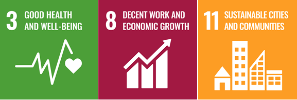
3"Good Health and Well-being"
8"Decent Work and Economic Growth"
11"Sustainable Cities and Communities"
Development of High-Temperature Thermal Energy Storage Materials for Achieving Stable Supply of Renewable Energy
Principal Researcher: KOBATAKE Hidekazu (Professor, Faculty of Science and Engineering Department of Environmental Systems Science)
Research Outline
Recent remarkable technological development has succeeded in reducing the cost of power generation from renewable energy. Despite of these successes, the proportion of renewable energy in total electric power supply is still insufficient to become a major power source.
This is due to the unstable power supply from renewable energy, which strongly depends on weather condition. To overcome this difficulty, thermal energy storage is attracting attention in the world. The thermal energy storage is one of the promising technologies that enable the stabilization of electric power supply from the renewable energy source. The aim of this project is development of a material with high heat-exchange ability at high temperature towards the realization of this future energy system.
Research Results
The widespread adoption of renewable energy remains a challenge despite its projected cost parity with fossil fuels by 2030. A major obstacle is the intermittent nature of solar and wind power, which leads to unstable energy supply. Thermal energy storage (TES) offers a promising solution by storing renewable energy as heat and releasing it when needed for stable power generation. Our research focuses on developing high-efficiency thermal storage and release materials and designing materials that prevent degradation under high temperatures.
In 2024, we developed a novel latent heat measurement method using a gas-jet levitation system. This technique enables precise measurement of the latent heat of high-melting-point metals without contamination. We also utilized the electrostatic levitation facility aboard the International Space Station to measure the surface tension, viscosity, and density of Fe-Cu alloys, which are potential TES materials. These properties are crucial for material design and optimization.
Our work could support SDG7 (Affordable and Clean Energy) by enhancing energy storage efficiency and SDG9 (Industry, Innovation, and Infrastructure) by contributing to advanced material development. Furthermore, through this project, we established an international collaboration to accelerate TES research.
Related SDGs
Toward improving educational inequality: development and evaluation of treatments for social communication disorders caused by hearing impairment using animal models
Principal Researcher:KOBAYASHI Kota (Professor, Faculty of Life and Medical Sciences Department of Biomedical Information)
Research Outline
[Background] Hearing loss is the most prevalent perceptual disability, and infantile hearing loss not only hinders language acquisition but also deprives opportunities to develop social communication skills and rise a risk of social isolation. To investigate the physiological mechanisms underlying hearing-impaired-related communication disability, we will utilize two types of model rodents: congenital hearing loss and early-stress-related communication disorder animals. This research will contribute to the Sustainable Development Goals (SDGs), particularly goals 3 (Good Health and Well-being), 4 (Quality Education), and 10 (Reduced Inequalities).[Research Plan] For the experiments on congenital hearing loss, we will employ MAP2 (Microtubule-associated protein 2) gene-deficient (MAP2 Knock out: MKO) mice, which our laboratory established as a model organism for peripheral hearing loss. For the experiments on early-stress related acquired communication disability, Mongolian gerbils that have experienced stress from being separated from their parents during their early developmental days will be used. Their hearing sensitivity will be assessed using the auditory brainstem response (ABR) test, a quantitative measure of neural activity in the auditory peripheral system. Additionally, the open field test, where two or more stranger animals placed in an observation arena and their behavioral responses to each other are recorded, will be conducted to evaluate their communication ability and quantify social development. We believe that this research proposal will help elucidate the biological basis of communication disorders and contribute to develop its treatment.
Research Results
Acquiring education requires a range of cognitive and social abilities, with communication being a fundamental skill. This research aimed to investigate how both congenital and acquired hearing loss affect communication abilities and to uncover the underlying mechanisms behind these effects.
Using a congenital hearing loss model in MAP2 gene-deficient mice, we assessed auditory function and social behavior. The results indicated that congenital hearing loss was associated with increased anxiety and impaired social development, highlighting the critical role of auditory input during early developmental stages.
To study acquired hearing loss, we used a model involving Mongolian gerbils separated from their mothers during early life. These animals showed reduced auditory sensitivity and altered vocalization patterns, such as changes in frequency modulation. Furthermore, they experienced difficulties in social interactions, particularly in cohabiting with conspecifics.Interestingly, some aspects of the communication deficits, especially those related to social behavior, showed signs of recovery when the affected animals interacted with normally developing peers. This suggests that certain impairments may be mitigated through social and environmental factors.Overall, this research demonstrates that hearing loss—both congenital and acquired—can significantly disrupt communication abilities and lead to atypical social development. These findings are important not only for advancing our understanding of neurodevelopment but also for informing educational and welfare strategies that support individuals with hearing impairments. By contributing to more inclusive educational environments, this research supports the goals of the Sustainable Development Goals (SDGs), particularly in addressing educational inequalities linked to sensory disabilities.
Related SDGs
Empirical Studies to Create LGBTQ+ Inclusive Communities
Principal Researcher:NAITO Tohru (Professor, Faculty of Commerce Department of Commerce)
Research Outline
The purpose of this study is to propose a prescription for realizing a more comfortable society for sexual minorities (LGBTQ+). According to a survey carried out by the Nippon Foundation in 2021, 20.8% of the Generation Z born between 1997 and 2003 said that they are LGBTQ+. It is now difficult to grasp gender in terms of male/female dualism, and measures to promote diversity based on the premise that SOGI (Sexual Orientation and Gender Identity) is diverse are required. In universities, which are institutions of higher education, it is essential and urgent to improve schooling and working conditions for LGBTQ+ students and faculty members, but research findings that can serve as the basis for such measures are very scarce. In light of this, we will survey and categorize the efforts of educational institutions in Japan and overseas, and conduct quantitative and qualitative analyses. Based on the findings, appropriate measures and policies for higher education institutions (mainly universities) will be identified. This research will also conclude an academic agreement with the University of Kitakyushu to promote the research more strongly. Specifically, the study will be conducted in the following order: survey (interviews), typology, quantification and prescription, and publication of findings.
Research Results
In recent years, gender inclusivity has become an increasingly critical issue, prompting educational institutions, including universities, to address the needs of LGBTQ individuals more proactively. While some countries, such as the United States and Taiwan, have legalized same-sex marriage and advanced social acceptance, others—like Japan—have yet to implement comparable legal or institutional recognition. Additionally, due to the sensitive and personal nature of LGBTQ issues, obtaining accurate and comprehensive data remains a significant challenge. This project aimed to investigate the lived realities of sexual minorities through interviews and discussions with LGBTQ individuals, alongside guidance from multiple faculty mentors. The goal was to identify key factors necessary for creating a society in which sexual minorities can live without stress or discrimination.Findings indicate that in Japan, there is a growing awareness of diversity, and initiatives promoting inclusion within educational institutions are gradually improving in both scope and quality. However, significant challenges remain—particularly regarding LGBTQ students’ anxieties around job hunting and future career prospects. Site visits to institutions abroad with more progressive frameworks revealed best practices and emphasized the importance of strengthening diversity-related initiatives at our university.
In conclusion, while positive steps are being made toward greater inclusivity in Japan, continued efforts are essential to ensure that LGBTQ individuals, especially students, can fully thrive within academic and professional environments. Future initiatives should focus on institutional reform, greater visibility, and creating safe spaces that affirm diverse identities.
Related SDGs
Investigating the Effect of Serious Game Development by University Students-on the subject of “alcohol,society and myself”-
Principal Researcher:NOMURA Yumi (Professor, Faculty of Social Studies Department of Social Welfare)
Research Outline
This study will work on a serious game that simulates solving social problems. University students will develop a serious game. The effects of the game are to be verified. We focused on the following two points. The process of game development promotes understanding of social structure. Games have two values. The two things they can do are to create and to play. There are two things that university students can gain. It can build partnerships with diverse actors. It also allows students to acquire life skills to confront social problems.
The theme that students will work on is goal 3.5. University students need to have a proper understanding of the impact on their bodies and minds, their families and immediate surroundings, and their communities. Students spend a year creating a game. The main theme is "Alcohol, Society and Myself. Addicts themselves, family members, professionals, facilitators, and others will provide support.
Research Results
This research utilizes serious games that simulate solving social problems and examines the development of such games by university students, as well as their effects, with an emphasis on the values of "making" and "playing" games. The students targeted Goal 3.5, "Strengthen the prevention and treatment of substance abuse, including drug abuse and harmful alcohol use," and chose the theme "Alcohol, Society, and Me." Participants, experts, facilitators, and others were involved in creating the game while relating "personal matters," "solving social problems," and "acquiring the background for solutions." The participants, experts, facilitators, and others involved in the creation of the game. The partnership formed through interaction with various stakeholders involved in social issues, such as alcoholics and their family members, supporters, and game developers, led to the acquisition of the motivation and knowledge necessary to address social issues. Responses from participants in the two game sessions, "Drunken Destiny" and "On the Rocks," which we created, deepened this motivation and background. We believe this element is necessary for young people to survive in today's society.
Related SDGs
Development of nano-micro fiber test method under various strain rate conditions
Principal Researcher:OBUNAI Kiyotaka (Professor, Faculty of Science and Engineering Department of Mechanical and Systems Engineering)
Research Outline
From the perspective of achieving the Sustainable Development Goals (SDGs), the use of lightweight materials such as polymer composites has garnered attention to reduce CO2 emissions from vehicles. Among the various methods to enhance the mechanical properties of composite materials, modifying the polymer matrix through the addition of nano- and microfibers is considered a simple and effective approach. Typically, the mechanical properties of composites, including those with added fibers, can be estimated by considering the mechanical properties of the additives. However, assessing the mechanical properties of nano- and micro- fibers themselves is challenging due to their small size. Furthermore, since most nano- and micro-fibers are made from polymers, their mechanical properties may exhibit strain rate dependency, yet there is currently no suitable test apparatus available to investigate these properties under dynamic loads in the nano- to micro-newton range. The objective of this theme is to develop a novel test method for evaluating the mechanical properties of nano- and micro-fibers under various strain rate conditions. By enabling easier investigation of the mechanical properties of these fibers, this new test method has the potential to accelerate the development of new materials. Ultimately, this research aims to contribute to the advancement of lightweight and sustainable materials for various applications, aligning with the goals of sustainable development.
Research Results
From the perspective of achieving the Sustainable Development Goals (SDGs), particularly those related to environmental sustainability and climate action, the use of lightweight materials such as polymer composites has garnered increasing attention. One of the most promising applications is in the transportation sector, where reducing vehicle weight directly contributes to lower fuel consumption and CO₂ emissions. To improve the mechanical performance of polymer composites, one effective and relatively simple approach is to enhance the polymer matrix by incorporating nano- and micro-scale fibers. These fibers, when properly integrated, can significantly improve the durability of the composite material.
However, accurately predicting the mechanical behavior of fiber-reinforced composites requires a fundamental understanding of the properties of the reinforcing fibers themselves. This becomes particularly challenging when dealing with nano- and microfibers due to their extremely small dimensions. Conventional mechanical testing methods are inadequate to deal with such small-scale fibers. Moreover, because most nano- and microfibers are composed of polymers, their mechanical properties are highly strain rate-dependent. Despite this, there has been a lack of an appropriate testing apparatus capable of evaluating these fibers under varying strain rate conditions in the nano- to micro-newton force range.
To address these issues, we developed a novel testing methodology, and a high-sensitivity load cell specifically designed for characterizing the mechanical properties of nano- and microfibers. These tools enable accurate measurements across a broad range of strain rates. Using the developed system, we successfully characterized the mechanical response of nanofibers under both quasi-static (approximately 0.01 s⁻¹) and high strain rate (up to 200 s⁻¹) conditions. This advancement provides a valuable foundation for the design of high-performance composite materials and offers insights into fiber behavior that were previously difficult to obtain.
Related SDGs
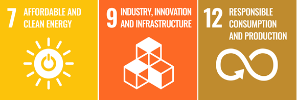
7"Affordable and Clean Energy"
9"Industry Innovation and Infrastructure"
12"Responsible Consumption and Production"
Research on Shukan Bunshun's Coverage, Reporting, and Power Monitoring
Principal Researcher:OGURO Jun (Professor,Faculty of Social Studies Department of Media, Journalism and Communications)
Research Outline
Compared with the existing mass media, such as newspapers and television, which have played a central role in journalism, how has Shukan Bunshun, which represents magazine journalism, maintained its uniqueness in terms of its power monitoring function? This study clarifies this. We attempt to derive a framework for the "Shukan Bunshun Model" that can be continuously implemented by analyzing the contents of the magazine and conducting interviews with former editorial staff. The results will be converted into oral histories that will be accessible to researchers at home and abroad.
For example, inequalities and disparities arise in society when "powers" such as politics, government agencies and corporations become corrupt and fail to function properly. Digging up and raising these issues is one of journalism's power monitoring functions.
This study empirically examines the reporting case of Shukan Bunshun through comparison with existing mass media. The research and development of the Shukan Bunshun Model is consistent with the SDGs' goal (10.3); "Ensure Equal Opportunities and End Discrimination." It is also directly linked to the SDGs' goal (16.5) ; "Substantially Reduce Corruption and Bribery."
Research Results
1) We reviewed the table of contents of approximately 700 issues of Shukan Bunshun over the past 14 years, extracted the most notable articles from each issue (top stories on the right and left), and digitized them.
2) A content analysis was conducted on all data listed in ① above using the quantitative text analysis tool "KH Coder." As a result, it became clear that the articles were directed at the center of power, for example, with the top three most frequently used words being "Abe," "Prime Minister," and "Suga." Another characteristic was that there were many articles related to the Imperial Family, and the quantitative data also supported the fact that the magazine actively covered taboo topics that other media do not cover extensively. Furthermore, it became clear that the magazine created headlines that link the articles mentioned above with words such as "scoop," "accusation," and "confession," which emphasize uniqueness. (As of March 2025, the analysis is ongoing, and further detailed analysis will be conducted.)
3) The above analysis reveals that Shukan Bunshun independently uncovers and rigorously pursues issues of corruption and improper functioning of "power" in politics, government, business, etc. The qualitative and quantitative surveys support the fact that Shukan Bunshun fulfills a unique power monitoring function that differs from other major media, which can be called the "Shukan Bunshun Model." This study reveals that the "Shukan Bunshun Model," which makes power monitoring sustainable, is directly linked to the SDGs' goals of "Ensure equal opportunity and reduce inequalities" (10.3) and "Substantially reduce corruption and bribery in all their forms" (16.5).
Related SDGs
Challenges and Prospects of Promoting Diversity in Private Universities:Towards Co-Creation of Diversity
Principal Researcher:SAKATA Mamiko (Professor,Faculty of Culture and Information Science Department of Culture and Information Science)
Research Outline
The Diversity Research Center of Doshisha University was selected by the Ministry of Education, Culture, Sports, Science and Technology (MEXT) in FY2021 for the "Initiative for Realization of Diversity Research Environment (Survey and Analysis)," a project funded by the MEXT's Grant-in-Aid for Human Resource Development for Science and Technology, and worked on the "Construction of Diversity Promotion Model in Private Universities. Through surveys of advanced cases in Germany, the U.S., and overseas through the T.I.M.E. Association, we developed a diversity promotion model to overcome the issues faced by private universities in Japan. As a result, the "Prescription for Promoting Diversity in Private Universities" is available on the Web as a content that can be used by private universities in Japan. (https://doshisha-diversity.jp/doshisha-sophia/prescription/)
This project revealed that many diversity promotion projects at private universities are still untapped, and that private universities are eager to exchange information and collaborate with other universities. In particular, the Ministry of Education, Culture, Sports, Science and Technology's diversity subsidy program, while bearing the title of "diversity," effectively targets only support for female researchers, and many policies that are considered good examples are difficult to apply to private universities with heavy educational and academic workloads.
Therefore, the purpose of this project is to survey and organize the status of diversity policies at private universities, which account for approximately 80% of all private universities in Japan, and to construct a "Diversity Promotion Portal that leverages the strengths of private universities" that implements the analysis results and conducts outreach to enable the dissemination of the portal. We expect that private universities, which are based on the spirit of the founding of the university and have their focus on education in order to contribute to the intellectual diversity of society, will have an extremely large influence on the realization of a diverse society.
Research Results
In this study, in collaboration with Kyoto Sangyo University, we conducted a follow-up investigation on the current state of diversity promotion initiatives at private universities in Japan, following the MEXT Diversity Initiative. Additionally, we carried out a public opinion survey on diversity and DEI, as well as an awareness survey targeting students enrolled in Doshisha University’s common education course, “Conscience of Doshisha and Diversity.” The university-level survey revealed a significant increase in the establishment of diversity-related committees and the publication of policy statements, while also exposing the lack of mature discussion and development in diversity domains beyond support for women and gender equity. The public survey showed that while over 80% of respondents considered diversity policies important, awareness and knowledge of the term “DEI” remained low, with many expressing limited interest. The student survey demonstrated strong motivation to learn more, with a wide range of interests including gender equality, multiculturalism, and privilege. “Discrimination” emerged as the most requested future topic. On March 4, 2025, we held the joint Diversity Symposium “Step by Step Toward an Exciting Tomorrow: Our Diversity,” co-hosted with Kyoto Sangyo University. The keynote lecture by journalist Ayako Oguni explored the emotional burden of engaging with diversity, while reports from both universities and a candid student panel discussion prompted wide-ranging reflections. Many participants expressed resonance and new insights, reaffirming the importance of engaging with diversity despite its complexities. Moving forward, the development of more comprehensive and effective diversity policies, along with continued awareness-raising efforts within and beyond the university, will be essential.
Related SDGs
How DX diversifies working practices for workers in SMEs: Towards effective recruiting human resources in Japanese SMEs
Principal Researcher:SEKI Tomohiro (Professor, Faculty of Commerce Department of Commerce)
Research Outline
Due to changes in the business environment, Japanese SMEs face a variety of management challenges, but one of these challenges, which has become particularly serious over the past few years, is securing human resources. DX is considered to be one solution to this problem.
DX is the concept of using digital technology to transform work and life for the better, and while a certain amount of digitalization appears to have progressed in SMEs, partly due to the growing infection of COVID-19, many SMEs are far from promoting digitalization, let alone DX. These SMEs have not been able to create diverse ways of working for their employees and, as a result, have been unable to secure the necessary human resources, which makes their continuity as a business entity unstable.
This study aims to identify the key elements of how DX can diversify the way employees work in Japanese SMEs. While it is generally known that the use of digital technologies can make work and life better for people working in companies, SMEs have not been able to achieve this. This project will use best-practice case studies to uncover the essentials of how promoting DX in SMEs can diversify the way employees work. This will help SMEs to secure effective human resources.
Research Results
This study aims to clarify the key points of how the work styles of employees diversify by promoting DX in SMEs, based on case studies of best practices. Specifically, I examined the following three cases. Sato Denki Seisakusho Co., Ltd., which specialises in the manufacture of enclosures, has equipped employees at its main Yamanashi factory with iPads, enabling them to manage nearly all internal operations through the devices. Additionally, the company has successfully enhanced employee motivation and attracted younger workers by utilising iPads as communication tools. Yamamoto Metal Manufacturing Co., Ltd., which develops and manufactures processing monitoring system equipment, utilises ‘precision processing technology’ and ‘measurement and evaluation technology’ to achieve high productivity for its customers. This company has succeeded in securing young employees, including graduate students, and is actively engaged in cutting-edge businesses. Manufacturing Partners, a network organisation of SMEs in manufacturing sector in Nagoya, utilises digital media to carry out various activities aimed at creating new businesses that are attractive to young people. The network organisation recruits many young managers and executives and is working to create a sense of fulfilment in work through manufacturing. What these cases have in common is that they are using digital technology to create organisations that are attractive to many young people. In order to effectively secure human resources for SMEs, it is essential to utilise digital technology and create attractive organisations that can motivate young people to work.
Related SDGs
Establishing a mentally and physically healthy developmental foundation in order to improve children’s educational environment
Principal Researcher:SHIROTA Ai (Researcher, Organization for Research Initiatives and Development)
Research Outline
This research focuses on the quality of sleep of caregivers and children and the home environment, with the goal of improving children's healthy development and educational environment. The results of the research are expected to help create and maintain a healthy environment for children's upbringing, and foster the aptitude for children to accept high-quality education (Goal 3: Health and Welfare, Goal 4: Quality Education). Improving the quality of life (QOL) of caregivers creates optimal well-being within the family and leads to improved parenting attitudes. On the other hand, in Japan today, the emotional poverty of caregivers is undermining the environment in which children should be raised.
The specific content of this research is to ask caregivers and children about their physical and mental conditions using a questionnaire, measure physical activity and heart rate during bedtime, and judge sleep quality from sleep efficiency and parasympathetic nervous system activity. Based on these indicators, we will evaluate the correlation between the sleep quality of caregivers and children, and examine the influence of the correlation between parent and child sleep quality on parenting attitudes. Mental and physical health and education are interconnected, and in order to provide high-quality education, we must improve mental and physical health, a goal that cannot be achieved. A sustainable challenge is to maintain a stable home environment for children, which is supposed to be a safe haven, and to connect this to the education of the children who will be responsible for the future.
Research Results
With the support of this project, we conducted a questionnaire survey involving 135 pairs of children aged 5 to 8 years and their mothers, and recorded their heart rate variability and physical activity levels while in bed at home. The analysis revealed that mothers with employment closer to full-time tended to have shorter sleep durations; however, this factor alone was not directly related to parenting stress or attitudes. Additionally, environmental factors such as maternal age, educational background, annual household income, division of housework, and number of children were not significantly associated with maternal sleep duration. In contrast, children whose mothers exhibited higher levels of negative parenting attitudes and parenting stress tended to sleep less. Moreover, the sleep rhythms of mothers and children were found to be significantly correlated. Children whose mothers went to bed and woke up early also tended to follow similar sleep schedules. Furthermore, sleep duration, heart rate variability during sleep, and body movement were positively correlated between mothers and children. These findings suggest that maternal sleep patterns may influence the sleep behavior of their children. While time management has long been a concern for mothers juggling childcare, work, and household responsibilities, these results highlight the importance of addressing the psychological burdens and relational challenges mothers face. Improving the caregiving environment may contribute not only to maternal well-being but also to better developmental conditions for children. Further detailed analyses will be conducted to clarify the causal mechanisms underlying the observed relationships and to explore intervention strategies that support mothers' peace of mind.
Related SDGs
A behavioral economic study on trust “gap” for generative AI: Developing nudges to promote digital education
Principal Researcher:TAGUCHI Satoshi (Professor,Faculty of Commerce Department of Commerce)
Research Outline
This study aims to elucidate, from a behavioral economics perspective that empathizes with human psychology, whether there is indeed a “gap” in the trust that educators and students place in generative AI in the educational field, and if so, what the cause might be. This issue arises from the possibility that a ‘gap’ may exist between the trust that the educator side has in generative AI and the trust that the student side has in it.
With the advent of generative AI such as ChatGPT, how to utilize technology in the field of education can be said to be an urgent issue. However, in reality, there is a risk that a gap or distortion may occur in the trust towards generative AI between teachers and students. This research aims to approach the cause of such a gap, aiming to solve the issues of SDGs No.4 ‘Education’, and also actively tackle the key issue that ‘the benefits and opportunities of digitalization are not sufficiently widespread’
Research Results
This study investigates the "gap" in trust towards generative AI between educators and students in educational settings from a behavioral economics perspective. The findings reveal significant differences: students show higher levels of trust and perceive lower risk to originality when using generative AI, whereas educators express a stronger intention to use the technology.
This research is significant as it provides quantitative evidence supporting previously qualitative observations regarding differing perceptions. It also offers new insights into the psychological tendencies related to AI use and highlights potential risks associated with its widespread adoption, particularly in terms of students' awareness of originality issues. The study's implications are crucial for shaping future educational policy and contribute to the SDG goals by promoting the responsive effective use of digital technology in education.
Related SDGs
Development of a novel therapeutic agent for COVID-19 that targets the Spike protein of SARS-CoV-2
Principal Researcher:TAKAHASHI Miho (Assistant Professor, Faculty of Life and Medical Sciences Department of Medical Life Systems)
Research Outline
Maintaining healthy biodiversity and ecosystems, while also preserving human health, is important for achieving a sustainable society. We aim to contribute to the maintenance of human health by developing inhibitors against SARS-CoV-2, which is spreading worldwide. Currently, antiviral drugs such as RNA polymerase inhibitors and virus protease inhibitors have been developed for COVID-19. However, there is concern about the emergence of resistant strains with decreased sensitivity to these drugs, emphasizing ongoing the importance of new drug development.
SARS-CoV-2 has spike proteins (S proteins) on the surface of its particles. These S proteins interact with ACE2 proteins present on the host cell membrane through the receptor binding domain (RBD) of the S protein ; this interaction is essential for the entry of SARS-CoV-2 into the cells. Our aim in this study is to develop SARS-CoV-2 inhibitors that target the RBD of the S protein, thereby inhibiting virus entry into target cells and subsequent virus propagation. In the previous Doshisha SDGs project, we successfully identified a series of tetravalent peptides that specifically bind to the RBD of the S protein using a multivalent peptide library technique that we developed. In this project, we will perform biochemical analysis and in vitro studies using pseudotype viruses. It is expected that new peptide-based SARS-CoV-2 inhibitors will be developed.
Research Results
The development of new therapeutic drugs for severe acute respiratory syndrome coronavirus 2 (SARS-CoV-2) is a crucial area of research contributing to the achievement of the Sustainable Development Goal 3 (SDG 3), which aims to ensure “good health and well-being for all people at all ages”. In this study, we are developing peptide-based SARS-CoV-2 inhibitors that target spike (S) protein located on the surface of the viral particle. The interaction between receptor binding domain (RBD) of the S protein and the angiotensin-converting enzyme 2 (ACE2) receptor expressed on the host cell membrane is essential for viral entry. To date, we have identified ten tetravalent peptides that bind to the RBD with high affinity through screening of a multivalent peptide library. We then examined the effects of these peptides on cell-cell membrane fusion, which is mediated by the interaction between the S protein and ACE2. As a result, five out of ten peptides efficiently inhibited membrane fusion in a dose - dependent manner. We also found that two of these peptides specifically inhibited membrane fusion induced by the S protein.
Related SDGs
Assessing investments in decarbonized power sources under uncertainty
Principal Researcher:TSUJIMURA Motoo (Professor,Faculty of Commerce Department of Commerce)
Research Outline
The capacity mechanism is an effective means to secure electricity supply capacity over the medium to long term and to promote climate change policy. In Japan, the capacity market, one of the capacity mechanisms, has been established and the auction has been implemented since 2020. However, this has not been enough to ensure a stable supply of electricity over the medium to long term, and the capacity market system has been under review. As part of the review, a long-term decarbonized power auction, a program to encourage new investments in decarbonized power sources, begins in 2024. In order to make the long-term decarbonized power source auction system more effective toward achieving carbon neutrality, an appropriate model for evaluating the generation capacity of decarbonized power sources is needed.
This research project will develop a model for assessing the value of decarbonized power generation capacity to answer the question: "How and to what extent does the long-term decarbonization power source auction system affect the mechanism for determining the value of the generation capacity of decarbonized power sources under medium to long term uncertainty?”Furthermore, utilizing actual data, we provide insights into the energy policy for achieving carbon neutrality. We will contribute to Goals 7, 9, and 13 of the SDGs through this research project.
Research Results
Concerns regarding the stability of electricity supply have been articulated, leading to the establishment of a Japanese capacity market in 2020 to ensure adequate generating capacity. Additionally, the Long-Term Decarbonized Energy Auction (LTDEA) was introduced in 2023 as a component of the capacity market, with the objective of providing long-term fixed income for power producers and promoting investment in decarbonized power sources to achieve carbon neutrality. The first auction took place in January 2024. According to the Seventh Energy Basic Plan, published in February 2025, the proportion of renewable energy in the energy mix for FY2040 is projected to be 40-50%. Within this projection, the target for wind power generation is approximately 4-8%; however, the actual share in FY2022 was merely 0.9%, and its expansion is anticipated to continue in the future.
This study investigates the valuation of wind power, a key focus of the LTDEA. Contrary to previous research on wind power valuations, this study considers the valuation of a wind farm in consideration of the LTDEA. In addition to the risks associated with variability in wind speed and electricity prices, the power producer faces the risk of capacity price fluctuations as determined by the LTDEA. We have developed a model to assess the investment in wind power under these risks.
Related SDGs
Research on the development of a programme for fostering the next generation to contribute to resource-conserving behavior.
Principal Researcher:URYUHARA Yoko (Professor,Faculty of Commerce Department of Commerce)
Research Outline
The goal of this series of research is to contribute directly to the achievement of the SDGs by developing and implementing educational programs and their evaluation indices that will enable the next generation to voluntarily take actions to conserve limited resources.
The objectives of this research are to (1) clarify the behavioral barriers, motivations, and values for making biodiversity conservation behavior a personal goal, develop programs based on these insights, implement them in society, and measure and evaluate them, and (2) examine the relationship between biodiversity conservation behavior and medical eco-behavior*1. When each individual takes actions to conserve the resources of the earth and medicine, they fulfill their responsibility to use them, protect the abundance of the oceans and land, and lead to health for all people. There are various approaches to promote this, but we focus on individual behavior change. This is because we believe that the process by which each individual recognizes what actions he or she can take and accumulates practices will influence various stakeholders, increase social impact, and form social norms.
As social implementation research, it is characterized by its direct contribution to problem solving and its interdisciplinary research that examines the mechanisms of attitudes and actions toward the SDGs across disciplines.
*1 Medical resource-friendly behavior. Source: Uryuhara (2022), Doshisha Shogaku, Vol. 74, No. 2, pp. 379-402.※https://o-socialmarketing.jp/
Research Results
This study is related to Goal 3, Goal 14, and Goal 15 of the Sustainable Development Goals (SDGs). The overall objective of the research series is to develop and implement programs and evaluation indicators that encourage the next generation to voluntarily engage in behaviors that value limited resources, thereby directly contributing to the achievement of the SDGs.
In the 2024 fiscal year, the study targeted men and women in their 20s and 30s, developing and implementing an “experiential booth” (e.g., a card game) designed to help participants recognize keys to solving social issues in their daily lives and to easily become more eco-conscious. The study also examined the relationship between biodiversity conservation behaviors and eco-conscious behaviors in the field of healthcare. Furthermore, a video summarizing the contents of the public implementation event was created, and a quantitative survey was conducted with a total of 1,000 participants (297 analyzed), stratified by gender and age groups (from 20s to 60s and above), to analyze their values and everyday eco-behaviors.
As a result, an educational program centered around the card game was developed and validated. The analysis revealed a correlation between biodiversity conservation behaviors (such as reducing household waste and participating in environmental protection activities) and eco-conscious health behaviors (such as getting 6–8 hours of sleep and eating a nutritionally balanced breakfast). These findings suggest that cross-sectoral contributions to the SDGs—such as linking Goal 3 (Health) and Goal 15 (Life on Land)—are possible.
Related SDGs

3"Good Health and Well-being"
4"Quality Education"
12"Responsible Consumption and Production"
13"Climate Action"
14"Life Below Water"
15"Life on Land"
High-dimensional data analysis for unraveling mechanism of intractable disease
Principal Researcher:YADOHISA Hiroshi (Professor,Faculty of Culture and Information Science Department of Culture and Information Science)
Research Outline
In recent years, elucidating the mechanisms underlying the onset of challenging diseases, such as dementia and cancer, has become crucial. As the pathology of these diseases progresses, they cause significant disruptions in the lives of patients, imposing social and economic stress. Consequently, early detection and development of treatment methods for these diseases are critical not only for medical research, but also for society at large. Advances in measurement technologies in life sciences have resulted in the collection of a plethora of data related to the onset of these diseases, including information on cellular DNA.
In life sciences, data observed in genomics, transcriptomics, methylomics, and other fields are collectively referred to as "omics," and data comprising multiple omics are termed "multi-omics data." Recently, there has been a growing expectation that multi-omics data can be used to elucidate the onset mechanisms of diseases such as dementia and cancer.
This study aims to develop a new analytical method to obtain a deep understanding of the pathophysiology and progression mechanisms of challenging diseases by leveraging high-dimensional data that are difficult to capture using existing methods. This study specifically focused on representing high-dimensional multi-omics data in a low-dimensional space associated with disease progression. This method aims to extract groups of genomes and proteins related to disease progression. Consequently, this study focuses on gene changes associated with dementia progression to elucidate the causes of dementia.
Research Results
Understanding the mechanisms behind the onset and progression of intractable diseases such as dementia and cancer has become a critical challenge in recent years. These diseases not only impair the quality of life of affected individuals but also place a significant burden on society and healthcare systems. Therefore, the early detection and development of effective treatments for such conditions are essential goals, not only for medical research but also for achieving broader societal well-being.
This study explores novel analytical approaches that leverage high-dimensional data—often difficult to interpret using conventional methods—in order to gain deeper insights into the pathology and progression of complex diseases. Specifically, the study focuses on two key methodologies: (1) representing multi-omics data in a lower-dimensional space that reflects the progression of disease, and (2) estimating individualized treatment effects that account for the heterogeneity among patients.By developing these analytical techniques, the research aims to contribute to a better understanding of gene-level changes associated with dementia progression, ultimately supporting the discovery of its underlying causes.
These efforts are closely aligned with the United Nations Sustainable Development Goals (SDGs), particularly Goal 3: Good Health and Well-being. Advancing personalized medicine and promoting early intervention for age-related diseases directly support the targets of ensuring healthy lives and promoting well-being for all at all ages. Moreover, by reducing the societal and economic impact of intractable diseases, the research also contributes to Goal 10: Reduced Inequalities, by promoting equitable access to effective treatments and preventive healthcare across diverse populations.
Related SDGs
Sustainable city with basic income and solidarity economy
Principal Researcher:YAMAMORI Toru (Professor, Faculty of Economics Department of Economics)
Research Outline
This research has two aims: 1. to trace forgotten collective practices that tried to actualise sustainable cities, and 2. to reconstruct what they could teach us for today.
My oral historical research on the British working-class women’s movement shows that they hoped for what can be called ‘degrowth’ today by constructing sustainable communities, along with their universal basic income demand for achieving gender equality. This research will make a hypothesis from this 'grassroots feminist thought'— the theory that it is necessary to have gender equality (SDGs 5), minimum income security (SDGs 1), and responsible production and consumption (SDGs 12) to achieve 'sustainable cities' (SDGs 11). Secondly, this research will examine the hypothesis. Thirdly, this research will find and trace other collective practices in history or today.
This research is, in sprit, related to the works and practices by Etsuji Sumiya (1895 -1987), an economist at Doshisha who was devoted to consumer cooperative movement.
Research Results
Oral history research with women involved in a prefiguring degrowth feminism movement in the UK in the 1970s and 1980s revealed that SDG Goal 11 (Sustainable Cities and Communities), SDG Goal 5 (Gender Equality), SDG Goal 1 (No Poverty) and SDG Goal 12 (Responsible Consumption and Production) are interlinked, and that achieving any one of these goals is essential to achieving the others.In addition, a survey of universities in North America and Europe that have implemented pioneering fragrance-free policies revealed the following: First, achieving SDG 11 'Sustainable Cities and Communities' requires both the regulation of harmful chemicals and the implementation of fragrance-free policies in public spaces. Second, there are several challenges that currently hinder the effectiveness of such policies. Third, it has become clear that achieving gender equality (SDG Goal 5), ensuring a level of income security (SDG Goal 1) and realising the responsibility to produce and consume sustainably (SDG Goal 12) are essential to overcoming these challenges.
